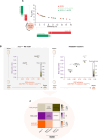Assessment of the FRET-based Teen sensor to monitor ERK activation changes preceding morphological defects in a RASopathy zebrafish model and phenotypic rescue by MEK inhibitor
- PMID: 38594640
- PMCID: PMC11005195
- DOI: 10.1186/s10020-024-00807-w
Assessment of the FRET-based Teen sensor to monitor ERK activation changes preceding morphological defects in a RASopathy zebrafish model and phenotypic rescue by MEK inhibitor
Abstract
Background: RASopathies are genetic syndromes affecting development and having variable cancer predisposition. These disorders are clinically related and are caused by germline mutations affecting key players and regulators of the RAS-MAPK signaling pathway generally leading to an upregulated ERK activity. Gain-of-function (GOF) mutations in PTPN11, encoding SHP2, a cytosolic protein tyrosine phosphatase positively controlling RAS function, underlie approximately 50% of Noonan syndromes (NS), the most common RASopathy. A different class of these activating mutations occurs as somatic events in childhood leukemias.
Method: Here, we evaluated the application of a FRET-based zebrafish ERK reporter, Teen, and used quantitative FRET protocols to monitor non-physiological RASopathy-associated changes in ERK activation. In a multi-level experimental workflow, we tested the suitability of the Teen reporter to detect pan-embryo ERK activity correlates of morphometric alterations driven by the NS-causing Shp2D61G allele.
Results: Spectral unmixing- and acceptor photobleaching (AB)-FRET analyses captured pathological ERK activity preceding the manifestation of quantifiable body axes defects, a morphological pillar used to test the strength of SHP2 GoF mutations. Last, the work shows that by multi-modal FRET analysis, we can quantitatively trace back the modulation of ERK phosphorylation obtained by low-dose MEK inhibitor treatment to early development, before the onset of morphological defects.
Conclusion: This work proves the usefulness of FRET imaging protocols on both live and fixed Teen ERK reporter fish to readily monitor and quantify pharmacologically- and genetically-induced ERK activity modulations in early embryos, representing a useful tool in pre-clinical applications targeting RAS-MAPK signaling.
Keywords: ERK; FRET; RASopathies; Zebrafish embryos.
© 2024. The Author(s).
Conflict of interest statement
The authors declare that they have no competing interests.
Figures






References
-
- Anastasaki C, Estep AL, Marais R, Rauen KA, Patton EE. Kinase-activating and kinase-impaired cardio-facio-cutaneous syndrome alleles have activity during zebrafish development and are sensitive to small molecule inhibitors. Hum Mol Genet. 2009;18:2543–54. doi: 10.1093/hmg/ddp186. - DOI - PMC - PubMed
MeSH terms
Substances
Grants and funding
LinkOut - more resources
Full Text Sources
Molecular Biology Databases
Research Materials
Miscellaneous

